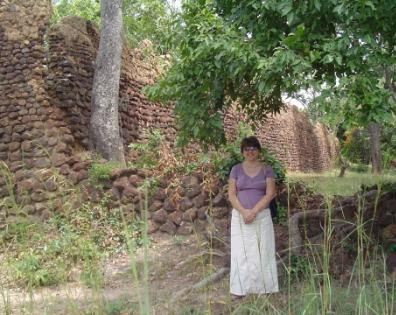Ancient Monuments

Much to our children’s frustration (especially when they were growing up), Marina and I have always had a certain curiosity about historic sites and old buildings. When we were first married we used to travel for miles up and down narrow country roads around Northern Ireland following signs which indicated the locations of some ancient Celtic or Druid ruin.
A couple of months ago the World Monuments Fund announced its 2008 World Monuments Watch List of 100 Most Endangered Sites. One of the threatened sites in Africa is the ruin of a stone structure in a village called Loropeni, about 25 miles from where we are currently living in Burkina.
Today, Marina and I went for a Sunday drive and decided to visit the site. We had been aware of the ruins, but never had the time to go see them, and to be honest, because no one had ever talked about them, we were not expecting to see very much.
After travelling along the dirt road between Gaoua and Loropeni for about 40 minutes, we came to a rusty old sign which indicated that we were near the ruins. We turned unto a narrow rocky road and just a few yards along we came to a control point with a huge log blocking the way.
After chatting for a few minutes with the attendant we parked the car and started walking along a dirt path into the bush. Half a mile or so later we came around a bend and were confronted by huge twenty foot high stone wall with trees growing out of it, and with large holes along the top where parts of the wall had fallen. The south face of the wall ran for at least 100 metres.
The guide gave us a brief tour around what can only be described as a fortress. The interior has an area covering 11,130 square metre (118,000sq ft). The guide explained that it had been built by the ninth king of the Gan people a couple of centuries ago. The Gan is a small ethnic group which is part of the Lobi group of tribes and has its own culture and language. The Loron is also a tribe within the Lobi family.
Inside the fortress, which had it own well, the men slept in square stone houses, while the women and children slept in round houses. Food and animals were also kept within the structure, and it would seem that they could have withstood a long siege. All of the interior buildings are now just piles of rocks.
The fortress had been occupied by hundreds of people, but when the king died, his body was buried within the structure, which made it a sacred, forbidden place, so it was abandoned and the people scattered around the local area and created new villages. Maybe by that time the need for high security had passed.
We were quite surprised at the scale and sophistication of the structure. The high walls were obviously there for protection, and very well built. It is basically square in shape with the walls thick on the bottom and narrowing slightly on the top. The mortar which held the stones together was made from a mixture of a certain type of mud and bones to give it strength and durability. In Ivory Coast we have seen the foundations of some small stone compounds, but nothing to compare with the size or complexity of this construction.
The Burkina Faso authorities are in the process of trying to get UNESCO to become involved in the protection and maintenance of the site, although the Burkinabé ministry of tourism seem to be doing a pretty good job up to this point. The main problem is the gradual degradation of the exterior walls, which have to contend with the extreme elements of Burkina Faso weather, especially during rainy season.
There is animated discussion among the various ethnic groups in the region about who exactly constructed and lived in the fortress, but I’m sure a careful excavation would reveal many interesting secrets of former times among the Gan and Lobi, and maybe even the Koulango peoples.

<< Home